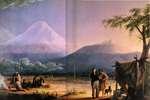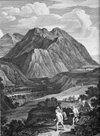Meeting 19 • 11 March 2014
|
Version: |
|
pictures of the week pictures of the week
|
|
|
|
mini-text of the week (start): "…What an odd experience it was to find ourselves in these vast solitudes with a man who believed he was European, with all the vain pretensions, hereditary prejudices and mistakes of civilization, but whose only roof was a tree."Humboldt, "Personal Narrative", from Jaguars and Electric Eels, ed. & trans. Wilson, pp. 70-71 (read more) |
|
•√ (05') Mini-text of the week: how "exotic" have you experienced the world (places, peoples)? what does "civilization" mean to you? what did it mean to Humboldt? Did he "go native"? More about H and his Prussian aristocratic society. |
|
•√ (05') Followup on last meeting's discussion of who "our people" are: An email received right after class, and a misunderstood overheard phone call. 1) The "carguero" incident (pretty good way to gauge your performance in the course): What did H do and think? Describe equivalent encounters with yourself in the place of H: what would you do? |
|
•√ (10') Today's installment of Humboldtian reading for me: A World of Rivers: Environmental Change on Ten of the World's Great Rivers, by Ellen Wohl (2011). The Nile and the Danube. Nile: sole source of water in a dry climate, with ancient culture, modern population / development pressure, and prospect of increasing tension within/among volatile societies. Danube: river developed heavily over long time, stable population, multinational region, serious demand for water but even more serious threat from industrial pollution. |
|
•√ (10') Culture contact, "clash of civilizations", individual reactions (even clashes within one person). The "Bennett Scale" or DMIS (Developmental Model of Intercultural Sensitivity): In whatever intercultural experience you have had (try to use specfici examples, not just general reference to people and places, where are you on this range? 1) Denial of Difference; 2) Defense against Difference; 3) Minimization of Difference; 4) Acceptance of Difference; 5) Adaptation to Difference; 6) Integration of Difference. What if the "natives" / "local yokels" don't want to benefit from our wisdom, goodness, and wealth? what if they do? When can indigenous languages (not) be saved? (Ostler, Nicholas. Empires of the Word: A Language History of the World). Indigenous peoples? |
|
•N (10') 99% vs. 1% (of a different kind than "us" vs. "the super-rich") Quick point about the Chimborazo graphic: Humboldt's pioneering work in plant (and animal) geography: the 99% perspiration and data are combined with 1% inspiration and insight to produce the monumental, iconic "Chimborazo" graphic. That was the best they had "back then" about sustainable environmentalism: the data, the thought, the presentation in words and pictures. There was NO "Big Science": no government-sponsored science (until late in 19thC in US - Powell's fights), no corporate-financed R&D. Well, there was a little, especially for military purposes (mapping, weapons). But most science was "amateur" (gentleman and a few others), because science then was not regarded as important. Producing that engraving involved huge effort and expense, even after the data was collected. –Some other "iconic" images related to science (whether as concepts or as means to deliver data effectively). –Special points: natural history collections; rarity of travel; topographic mapping (Wikipedia; Geosciences, Idaho State U) |
|
•√ (10') Small group discussion of the books you're now reviewed. Suggested organization by topics: exploration and adventure; bio-sciences; math/ physics; history, economics, politics (philosophy?); biographies; off-beat topics (foodie books, Descartes' brain, dark side of 19th-C painting) |
|
•√ (10') Grants, jobs, résumé lines (cont'd.): 1) PSU Sustainability Institute – link "get involved: students") - current opportunities • off-campus opportunities; events; education • May 7, 2014: PSU Student Research Symposium (and online proposal form) May 29, 4-6 pm, 7th Annual Sustainability Celebration; PSU sustainability travel awards for students (check with them to see whether money is available at present). Example of a successful conference presentation proposal: "The 'Humboldt Project:' Outreach to K-12 At-Risk Students through Experiential Learning about Sciences, Social Sciences, Humanities, Environmentalism and Sustainability" (U of Hawaii, January 2009) Example of a successful travel funding request narrative (HICAH 2012) Example of a successful small grant proposal: developing STEM materials for language learners Example of conferences suitable for presentations based on this course, by students from the course: Hawaii International Confrence on Arts & Humanities (mid-January); American Association for Sustainability in Higher Education (AASHE); Smart and Sustainable Campuses Conference (March, 2014, Maryland); European Association for Research on Learning and Instruction (EARLI), 16th Biennial conference, Limassol, Cyprus, 25-29 August 2015 (also has a JURE - JUnior REsearchers conference on 4 July, 2014, in Nicosia, Cyprus) Study (scholarship) opportunities: DAAD; for later in careers: Alexander von Humboldt Foundation; Something more adventurous: the tall ship Alexander von Humboldt II; today (11 March) she is right near Tenerife |
|
•N (10') Recalling, sorting, expressing our knowledge of Humboldt and the origins of sustainable environmentalism. Suggest small group discussions of these topics: life, travels, world-view; research (events, methods, concepts, data); people(s) – maybe split into bioscience and math/physics etc.; cultures, economics, politics, ethics; the relation of those topics to sustainable environmentalism (then AND now) - (re)interpreting the past AND the present |
|
•N (05') Advice (result of coffee with one of you) about "educated citizen" reading, with examples (individual texts, publications - with free copies). Why I regularly read publications that I usually disagree with. |
|
•+ (05') Preview of final exam: 1) parts; 2) strategy advice; 3) file / paper management; 4) rules Copies of the focus article to read for the final How to manage parts of your species description and group projects that aren't digital: see note on assignments/ deadlines page. |
|
• On the horizon: How did/do people "feel" about nature and environmentalism? (NOT expressing opinions, but rather the psychological / emotional sense, including how we can encounter their thoughts / emotions Presentation about society back then (and any time before 1800 or so), to help understand how H related to people of other classes / races (teaser: When was it that someone's ears first popped with a change in altitude?) Meeting #20: Practice for the final, wiht short sample articles and discussion topics. |

